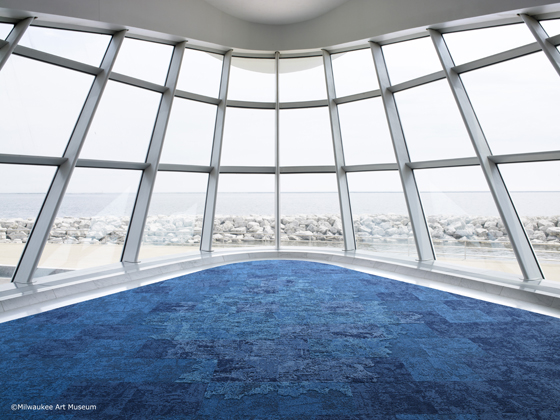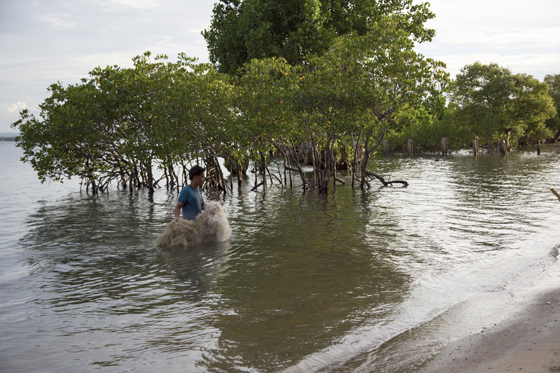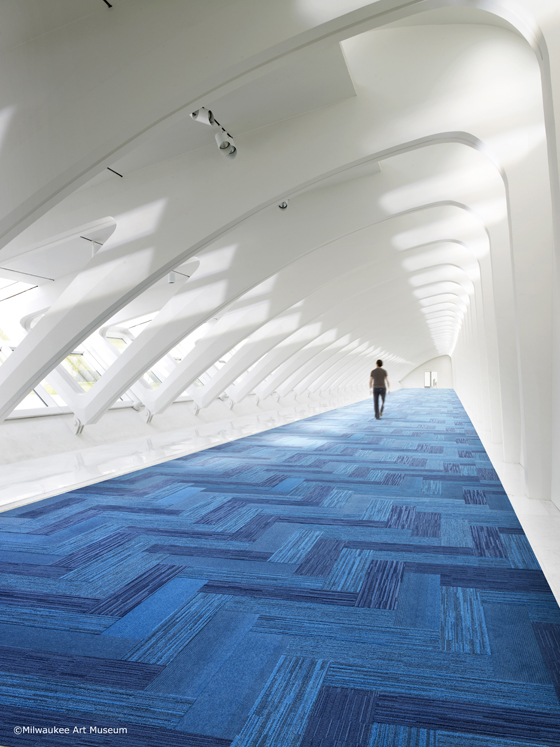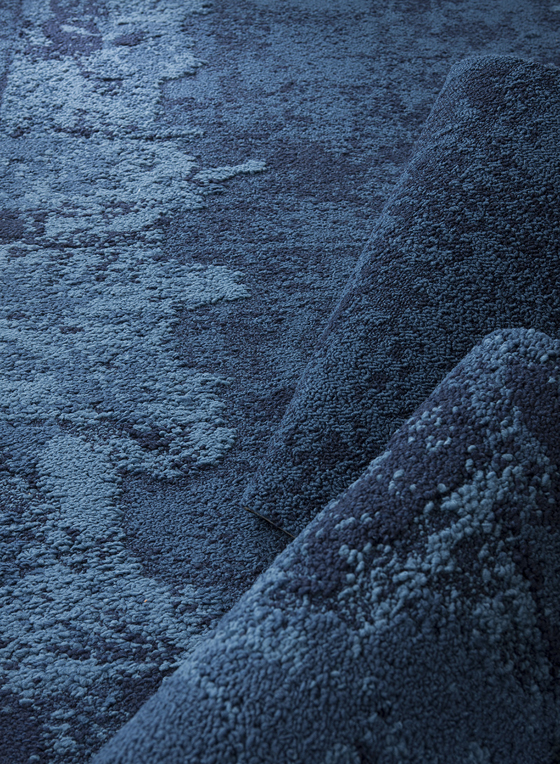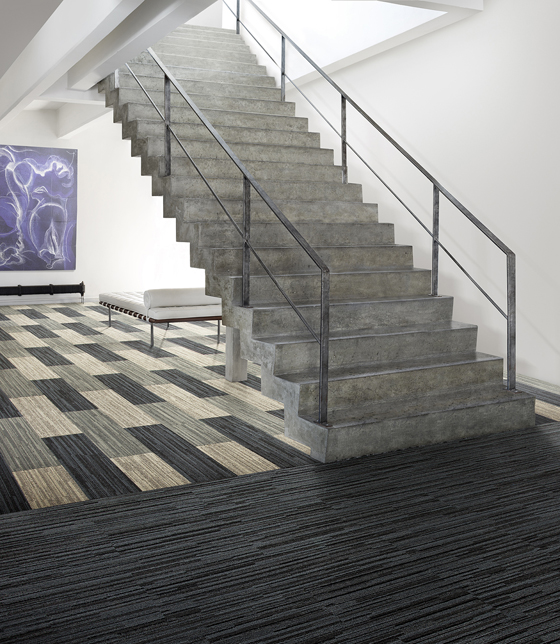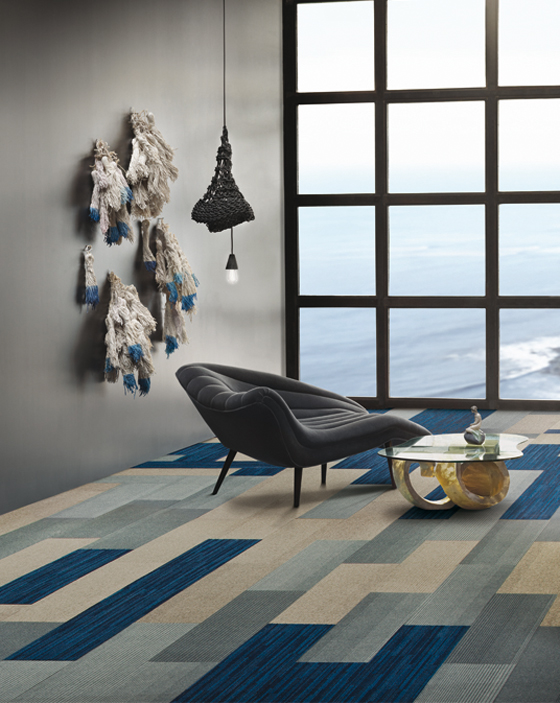Sustainability and Beauty: Interface introduces Net Effect™
Text by Interface
Krefeld, Germany
07.11.13
The new modular collection of Interface is evocative of the waves of the oceans. For the design, Interface worked exclusively with the world famous designer David Oakey. Consciously breaking through previous design boundaries, and reaching a new level of social and environmental sustainability, makes the new collection particularly special. Something more: Net Effect contains 100 percent recycled yarn – partially derived from discarded fishing nets. By doing so, it unifies sustainability and beauty in a unique manner. It ties in with the newest sustainability project Net-Works: collecting fishing nets from the Philippines and integrating them into the carpet tiles’ production.
The carpet tile manufacturer, Interface, is no stranger to thinking outside the box and has recently presented the Net Effect collection in Berlin and Vienna. Inspired by the sea, the latter has journeyed beyond the typical design boundaries of carpet squares and planks. And now, it is breaking through to new levels of environmental and social responsibility, sustainability and a next wave in product design.
Net Effect contains 100 percent recycled content yarn. The yarn is made out of various sources including used carpet fluff, harvested from Interface’s ReEntry® program, and commercial fishing nets. A new modular carpet collection, Net Effect is inspired by both, the ocean’s life-giving power, as well as its plight – marine life and habitats endangered by discarded fishing nets, acidification, over-fishing, pollution and climate change. It is reflective of Interface’s abiding Mission Zero® promise to eliminate any negative impact it may have on the environment by 2020.
_
Discarded fishing nets and old carpet tiles as sustainable raw material source
An innovative global business and conservation partnership between Interface and the conservation charity, Zoological Society of London (ZSL), has launched the pilot project Net-Works in the Danajon Bank area of the Philippines in 2012, tackling two distinct issues: first, to address the growing environmental problem of discarded fishing nets in some of the world’s poorest coastal communities, and second, to help solve the problem of finding a viable waste stream to feed the company's ambitious post-consumption nylon recycling goals.
The remaining share of recycled yarn, necessary for producing the Net Effect collection, comes from Interface’s ReEntry program. The latter consists in recycling and reusing carpet tiles once their life cycle has come to an end. Aquafil, one of Interface’s key suppliers, has refined the technology of recycling nylon waste into new nylon carpet fiber.
More information about the ReEntry program can be found here:
“Interface’s business is built around inspiration, innovation and the pursuit of true sustainability – economic, environmental and social,” to quote Chip DeGrace, executive creative director for Interface. “Products like Net Effect –- and programs like Net-Works – demonstrate how creative thinking can change the way we do business and move us closer to the ultimate goal of being a restorative enterprise.”
_
The Ocean as a Source of Natural Design
The Net Effect product collection provides a subtle visual reminder of the sea on its surface, with a design reminiscent of swirling currents. Created by David Oakey, owner of David Oakey Designs, an exclusive designer for Interface, the collection embraces sustainability in construction and concept.
“Aesthetically, we wanted Net Effect to capture the positivity of the Net-Works partnership and the beauty of the waters it’s so closely tied to,” said Oakey. “This collection connects people with the emotions and memories associated with the beach, but their enjoyment is its most superficial benefit. What’s beneath the surface—including the product’s ties to the good work Net-Works is doing—is what makes it extraordinary.”
Net Effect’s three 50cm square tiles supplement well the 25x100cm skinny planks, evoking an image of the sea, washing its waves over land. The square and plank tiles’ shared coastal color palette of two blues and six neutrals, was drawn from the depths of the ocean, combined with the sun-and-salt-bleached wood and stone found on shore.
More information about Net Effect can be found under this video link:
More information about Net-Works can be found under this video link:
_
About Interface
Interface is a global leader in the design and production of carpet tiles. Its products combine beauty and innovation with functionality and environmental credentials to help customers bring their design vision to life.
Interface was one of the first companies to publicly commit to sustainability, when it made a pledge in the mid-nineties to eliminate its impact on the environment by 2020. Known as Mission Zero®, it influences every aspect of the business and inspires the company to continually push the boundaries in order to achieve its goal.
Interface is now more than half way to reaching Mission Zero and has been widely recognised for its achievements to date. Its products have also achieved several awards, specifically for design and innovation, one of the most recent being The Athenaeum Good Design Award for World Textiles.
About ZSL
Founded in 1826, the Zoological Society of London (ZSL) is an international scientific, conservation and educational charity whose mission is to promote and achieve the worldwide conservation of animals and their habitats. Our mission is realised through our groundbreaking science, our active conservation projects in more than 50 countries and our two Zoos, ZSL London Zoo and ZSL Whipsnade Zoo. For more information visit:
About Aquafil
Since 1969, Aquafil has been one of the leading players, both in Italy and globally, in the production of polyamide 6. The Aquafil Group has a presence in seven countries on three continents, employing more than 2200 staff at 13 plants located in Italy, Germany, Slovenia, Croatia, the USA, Thailand and China. Always committed to taking real measures to protect the environment, in 2011 Aquafil started the ECONYL ® Regeneration System project. It is an innovative industrial regeneration process that produces nylon 6 polymer from:
• Post-consumer waste, i.e. end-of-life products made from polyamide 6, including fishing nets, fluff (from the top of carpets and rugs) and textiles;
• Pre-consumer waste such as oligomers, scraps, etc., generated from the production of nylon.
_
Press Contact
Pressebüro Interface
c/o public link GmbH
Simone Krist
Tel. +49 (0) 30 44 31 88 – 17
E-Mail: interface@publiclink.de

